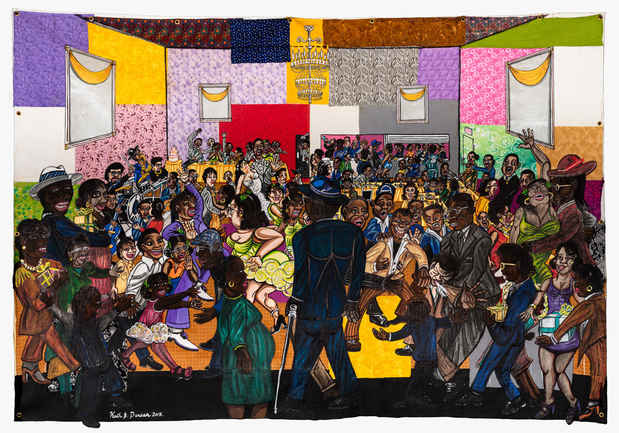Keith Duncan “The Big Easy”
Fort Gansevoort

[Image: Keith Duncan "The Wedding" (2015) Acrylic on unstretched canvas with fabric, 93 × 137 in.]
This event has ended.
Fort Gansevoort presents The Big Easy, featuring new work by New Orleans, Louisiana-based artist Keith Duncan, opening on Thursday, January 10th. Keith Duncan is a visual storyteller, depicting stories both familiar to all and those specific to New Orleans, with a focus on a multidimensional approach both in subject matter and material.
The Big Easy consists of two large-scale paintings portraying two scenes recognizable to all, The Wedding and The Funeral, both part of Duncan’s series Satire and Storytelling. These are two scenes with curiously more similarities than differences. Through Duncan’s expressive and at times comical form of visual storytelling, one will recognize many of the familiar characters in such scenes. The wedding is not without a couple of fights, the drunk uncle, and even a fainting bride. Similar roles are filled in The Funeral, including a separate party of men drinking outside of the reception created on the right side of the house. The bodies and heads of Duncan’s figures are as if carved from a block of wood rather than paint, resulting in hyper-expressive faces. All of Duncan’s chiseled faces can be seen at once. This rudimentary depiction of the many bodies filling the dance floor of The Wedding causes an effect reminiscent of procession paintings of The Renaissance, where every single figure’s face can be seen fully by the viewer, giving little importance to the depiction of a realistic point of view.
In an effort to tie himself through material native to his Southern Roots, Duncan pulled inspiration from Faith Ringgold and Gee’s Bend Quiltmakers. In recent works from the past ten years, Duncan’s walls, ceilings, and surfaces have been livened by patterned fabrics.
The third large-scale painting in the exhibition, titled The Black Saints Go Marching In, is a tribute to the first chapter of Robert Farris Thompson’s book Flash of the Spirit. The painting stays true to Duncan’s roots by tying in the city’s beloved football team the New Orleans Saints as the subject. Flash of the Spirit describes the influence of aesthetics of five African civilizations on the art practices of black artists today. The mask highlighted at the bottom-center of Duncan’s painting is pulled from the cover of the book.
Having grown up in Plaquemines Parish and later moving to New York and then back down to New Orleans post-Hurricane Katrina, Duncan is very familiar with the effects of the hurricane both on the ground and the misunderstandings made from afar. The local newspaper following the tragedy of Hurricane Katrina described the event as if the hurricane had ripped the Mardi Gras mask off of New Orleans to reveal disaster and misfortune. This inspired Duncan’s series titled Times Picayune, the name of the city newspaper, where he illustrates the two sides of New Orleans. One side is that of celebrations, bright colors and costumes understood to define New Orleans through the eyes of tourists. The other side is that of the living reality of locals; often defined by poverty, homelessness and crime. Through a collage-like approach to these paintings, Duncan makes use of recognizable imagery seemingly pulled from brochures or tourism posters of the city. He then pairs these vibrant images with monochromatic depictions of locals often depicted in eerie colors in an effort to require the viewer to take a closer look to reveal the hardships and realities of this city.
The third body of work included in the exhibition is titled, Black Plight. This series consists of nine small paintings of historical events divided up thematically and by time period; such as Reconstruction Era, Civil Rights Era, and Black Star Era. The series culminates in one large painting that acts as a visual timeline highlighting moments of great progress in African American history, from slavery to the Obamas. Here also, Duncan makes use of patterned fabric as an homage to the work of the great southern women of Gee’s Bend.
Through a blend of material, historical references, events and icons, Duncan creates a multidimensional vision of the American South and more specifically New Orleans, Louisiana.
Keith Duncan was born in Plaquemines Parish, Louisiana in 1967. He received a BFA from Louisiana State University, and an MFA from Hunter College (CUNY) New York, NY. The CUE Arts Foundation New York presented a solo exhibition of his work, followed by inclusion of all works from the exhibition in Prospect.2 by curator Dan Cameron. Further solo exhibitions include the Ohr-O’Keefe Museum of Art in Biloxi, Mississippi and Corridor Gallery, Brooklyn, NY. Duncan was included in Thelma Golden’s “Black Romantic” exhibition at the Studio Museum in Harlem in 2002. Further selected group exhibitions include the Ogden Museum of Southern Art in New Orleans, LA, Paul and Lulu Hilliard University Art Museum in Lafayette, LA, Art in General, David Beitzel Gallery, Rush Arts Gallery, Williamsburg Music Center, Brooklyn, NY, Bronx River Arts Center, The Museum of Contemporary Art, Pontiac, MI, Tustin Center, Philadelphia, PA, and the Artist Center & Gallery, Richmond, VA. Duncan is included in the permanent collections of the Ogden Museum of Southern Art and the New Orleans Museum of Art. His awards include the Camille Cosby Fellowship, The Joan Mitchell Foundation Grant, and in 2001 his work was commissioned for NASA. Residencies include Skowhegan School of Painting & Sculpture, Skowhegan, ME. Duncan has taught art for over twenty years in New York and New Orleans. Duncan currently resides in New Orleans and is represented by Fort Gansevoort, New York.
Media
Schedule
from January 10, 2019 to February 23, 2019
Opening Reception on 2019-01-10 from 18:00 to 20:00